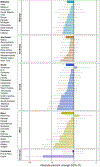Variation in hysterectomy prevalence and trends among U.S. States and Territories-Behavioral Risk Factor Surveillance System, 2012-2020
- PMID: 37329443
- PMCID: PMC10643045
- DOI: 10.1007/s10552-023-01735-6
Variation in hysterectomy prevalence and trends among U.S. States and Territories-Behavioral Risk Factor Surveillance System, 2012-2020
Abstract
Purpose: We estimated up-to-date state- and territory-level hysterectomy prevalence and trends, which can help correct the population at risk denominator and calculate more accurate uterine and cervical cancer rates.
Methods: We analyzed self-reported data for a population-based sample of 1,267,013 U.S. women aged ≥ 18 years who participated in the Behavioral Risk Factor Surveillance System surveys from 2012 to 2020. Estimates were age-standardized and stratified by sociodemographic characteristics and geography. Trends were assessed by testing for any differences in hysterectomy prevalence across years.
Results: Hysterectomy prevalence was highest among women aged 70-79 years (46.7%) and ≥ 80 years (48.8%). Prevalence was also higher among women who were non-Hispanic (NH) Black (21.3%), NH American Indian and Alaska Native (21.1%), and from the South (21.1%). Hysterectomy prevalence declined by 1.9 percentage points from 18.9% in 2012 to 17.0% in 2020.
Conclusions: Approximately one in five U.S. women overall and half of U.S. women aged ≥ 70 years reported undergoing a hysterectomy. Our findings reveal large variations in hysterectomy prevalence within and between each of the four census regions and by race and other sociodemographic characteristics, underscoring the importance of adjusting epidemiologic measures of uterine and cervical cancers for hysterectomy status.
Keywords: Behavioral Risk Factor Surveillance System; Cervical cancer; Hysterectomy; Prevalence; Uterine cancer; Women's health.
© 2023. This is a U.S. Government work and not under copyright protection in the US; foreign copyright protection may apply.
Conflict of interest statement
Competing interests
The authors did not report any conflicts of interest.
Figures

Similar articles
-
Higher prevalence of hysterectomy among rural women than urban women: Implications for measures of disparities in uterine and cervical cancers.J Rural Health. 2022 Mar;38(2):416-419. doi: 10.1111/jrh.12595. Epub 2021 Jun 3. J Rural Health. 2022. PMID: 34081371 Free PMC article.
-
The impact of adjusting for hysterectomy prevalence on cervical cancer incidence rates and trends among women aged 30 years or older-United States, 2001-2019.Am J Epidemiol. 2024 Aug 5;193(8):1097-1105. doi: 10.1093/aje/kwae041. Am J Epidemiol. 2024. PMID: 38583940 Free PMC article.
-
US hysterectomy prevalence by age, race and ethnicity from BRFSS and NHIS: implications for analyses of cervical and uterine cancer rates.Cancer Causes Control. 2022 Jan;33(1):161-166. doi: 10.1007/s10552-021-01496-0. Epub 2021 Sep 21. Cancer Causes Control. 2022. PMID: 34546462 Free PMC article.
-
Hysterectomy-corrected cervical cancer mortality rates reveal a larger racial disparity in the United States.Cancer. 2017 May 15;123(6):1044-1050. doi: 10.1002/cncr.30507. Epub 2017 Jan 23. Cancer. 2017. PMID: 28112816
-
Uterine cancer incidence trends and 5-year relative survival by race/ethnicity and histology among women under 50 years.Am J Obstet Gynecol. 2024 Nov;231(5):526.e1-526.e22. doi: 10.1016/j.ajog.2024.06.026. Epub 2024 Jun 24. Am J Obstet Gynecol. 2024. PMID: 38925206
Cited by
-
Associations between dietary inflammatory index with menopause and hysterectomy: findings from a national health and nutrition examination survey.BMC Public Health. 2025 Apr 15;25(1):1419. doi: 10.1186/s12889-024-21235-9. BMC Public Health. 2025. PMID: 40234796 Free PMC article.
-
Comprehending unwanted hysterectomies in developing nations: an analysis of women's decision-making processes, underlying causes, and subsequent consequences.Ann Med Surg (Lond). 2024 Oct 8;86(11):6404-6406. doi: 10.1097/MS9.0000000000002642. eCollection 2024 Nov. Ann Med Surg (Lond). 2024. PMID: 39525732 Free PMC article. No abstract available.
-
Cervical cancer incidence and trends among women aged 15-29 years by county-level economic status and rurality - United States, 2007-2020.Cancer Epidemiol. 2025 Feb;94:102730. doi: 10.1016/j.canep.2024.102730. Epub 2024 Dec 31. Cancer Epidemiol. 2025. PMID: 39742680 Free PMC article.
-
Indigenous, integrative, and biomedical perimenopause and postmenopause healthcare for Indigenous midlife peoples residing in the United States and Canada: A scoping review.medRxiv [Preprint]. 2025 Jul 11:2025.07.10.25331221. doi: 10.1101/2025.07.10.25331221. medRxiv. 2025. PMID: 40672467 Free PMC article. Preprint.
-
SAHELI: Study and Action on Hysterectomy: Evidence on women's health through the life course in India. Protocol for a mixed-methods study.Wellcome Open Res. 2025 Mar 5;9:584. doi: 10.12688/wellcomeopenres.23084.2. eCollection 2024. Wellcome Open Res. 2025. PMID: 39925664 Free PMC article.
References
-
- Fingar KR, Stocks C, Weiss AJ, Steiner CA. Most Frequent Operating Room Procedures Performed in U.S. Hospitals, 2003–2012. Healthcare Cost and Utilization Project (HCUP) Statistical Briefs. Rockville (MD): Agency for Healthcare Research and Quality (US); 2014.
-
- Whiteman MK, Hillis SD, Jamieson DJ, Morrow B, Podgornik MN, Brett KM, et al. Inpatient hysterectomy surveillance in the United States, 2000-2004. Am J Obstet Gynecol. 2008;198:34.e1–7. - PubMed
-
- Wallace SK, Fazzari MJ, Chen H, Cliby WA, Chalas E. Outcomes and Postoperative Complications After Hysterectomies Performed for Benign Compared With Malignant Indications. Obstet Gynecol. 2016;128:467–75. - PubMed
MeSH terms
Grants and funding
LinkOut - more resources
Full Text Sources
Medical

